

Compact Muon Solenoid
LHC, CERN
| CMS-PAS-BPH-23-005 | ||
| Search for $ CP $ violation in $ \mathrm{D}^0\to\mathrm{K}^0_{\mathrm{S}}\mathrm{K}^0_{\mathrm{S}} $ decay from proton-proton collisions at 13 TeV | ||
| CMS Collaboration | ||
| 26 March 2024 | ||
| Abstract: A search is reported for $ CP $ violation in the $ \mathrm{D}^0\to\mathrm{K}^0_{\mathrm{S}}\mathrm{K}^0_{\mathrm{S}} $ decay, using data collected from proton-proton collisions at $ \sqrt{s} = $ 13 TeV recorded by the CMS experiment in 2018. A dedicated data set of about 10 billion events containing a pair of b hadrons, nearly all of which decay to charm hadrons, is used. The flavor of the neutral D meson is determined by the pion charge in the reconstructed decays $ \mathrm{D}^{*+}\to\mathrm{D}^0\pi^+ $ and $ \mathrm{D}^{*-}\to\overline{\mathrm{D}}^0\pi^- $. The $ CP $ asymmetry in $ \mathrm{D}^0\to\mathrm{K}^0_{\mathrm{S}}\mathrm{K}^0_{\mathrm{S}} $ is measured to be $ A_{CP}(\mathrm{K}^0_{\mathrm{S}}\mathrm{K}^0_{\mathrm{S}}) = $ 6.2 $ \pm $ 3.0 (stat) $\pm$ 0.2 (syst) $\pm$ 0.8 $(A_{CP}(\mathrm{K}^0_{\mathrm{S}}\pi^+\pi^-))$ %, where the last uncertainty is the $ CP $ asymmetry in the $ \mathrm{D}^0\to\mathrm{K}^0_{\mathrm{S}}\pi^+\pi^- $ decay. This result is consistent with no $ CP $ violation within 2 standard deviations. This is the first measurement of $ CP $ violation in the charm sector by the CMS experiment, and the first measurement of $ CP $ asymmetry in the fully hadronic final state performed by CMS at the nominal LHC luminosity, using the new data parking technique. | ||
| Links: CDS record (PDF) ; CADI line (restricted) ; | ||
| Figures | |
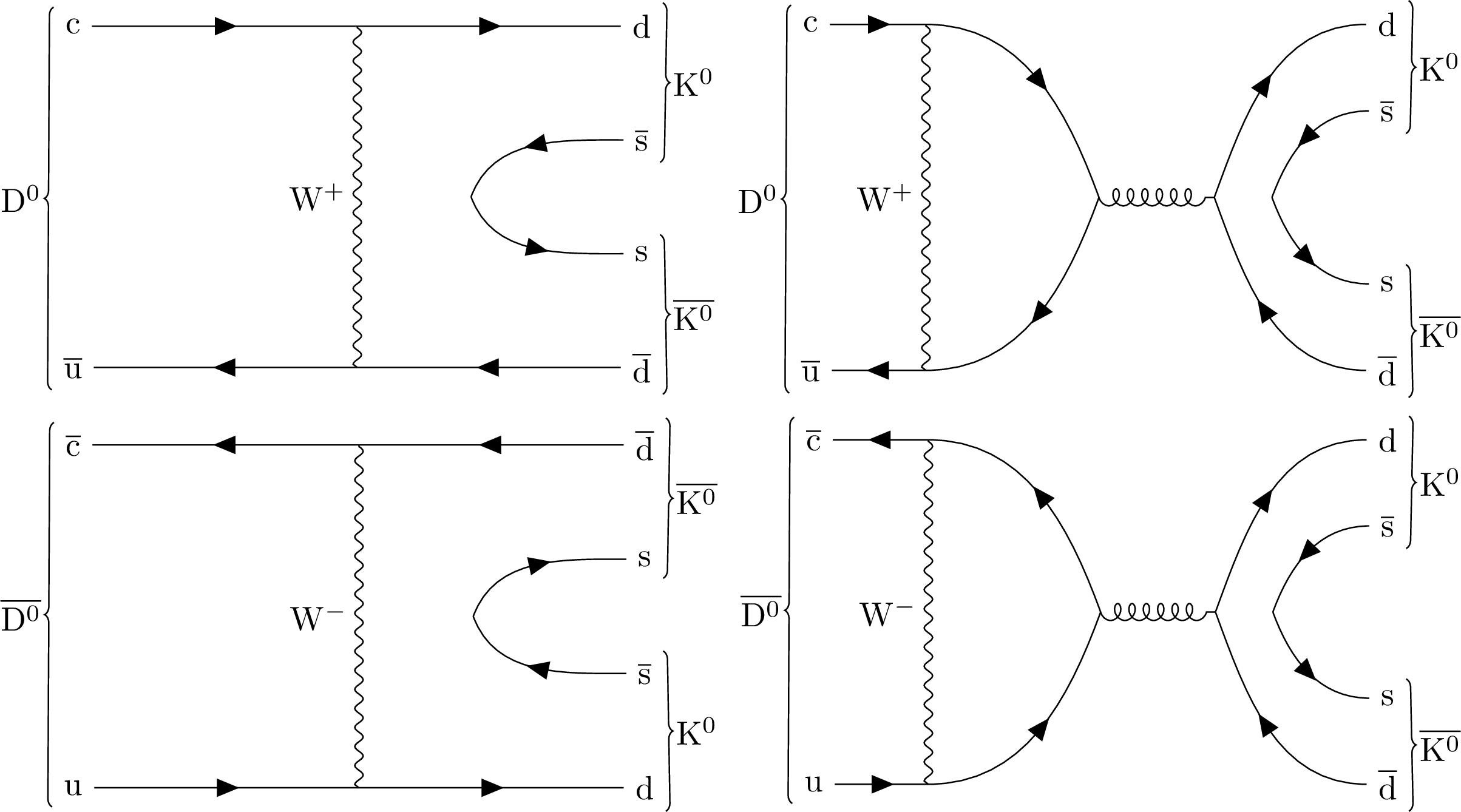
png pdf |
Figure 1:
The decay of neutral charm meson $ \mathrm{D^0} $ (top) or $ \overline{\mathrm{D}}^{0} $ (bottom) to two neutral kaons: exchange diagram (left) and penguin annihilation diagram (right). |
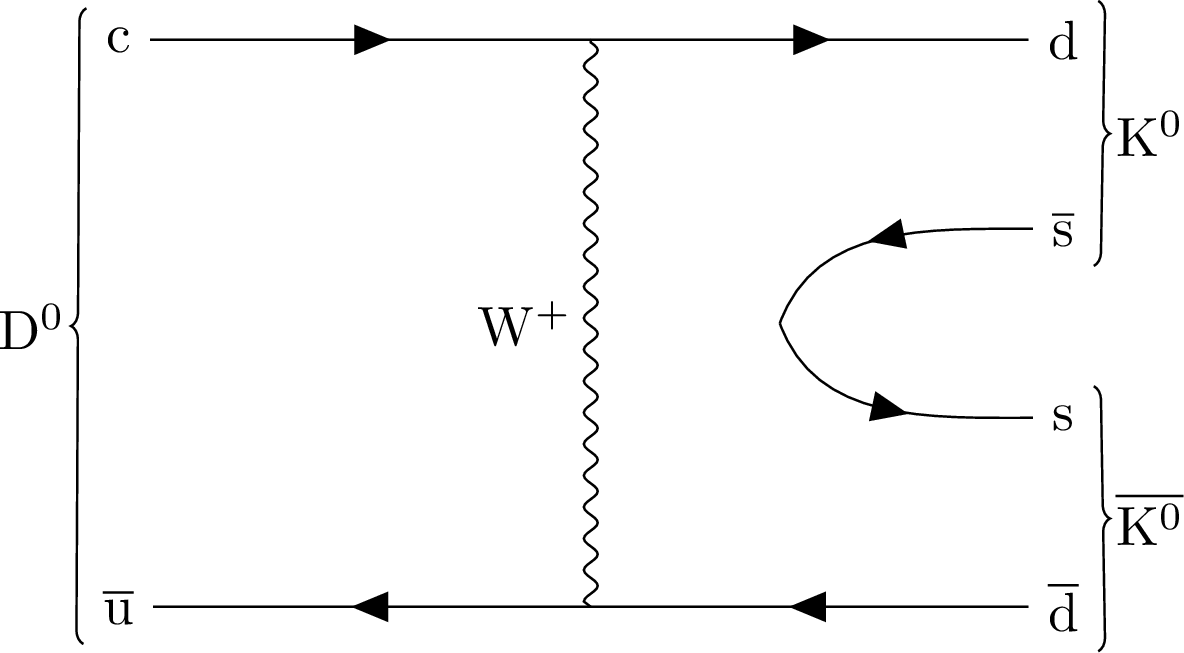
png pdf |
Figure 1-a:
The decay of neutral charm meson $ \mathrm{D^0} $ (top) or $ \overline{\mathrm{D}}^{0} $ (bottom) to two neutral kaons: exchange diagram (left) and penguin annihilation diagram (right). |
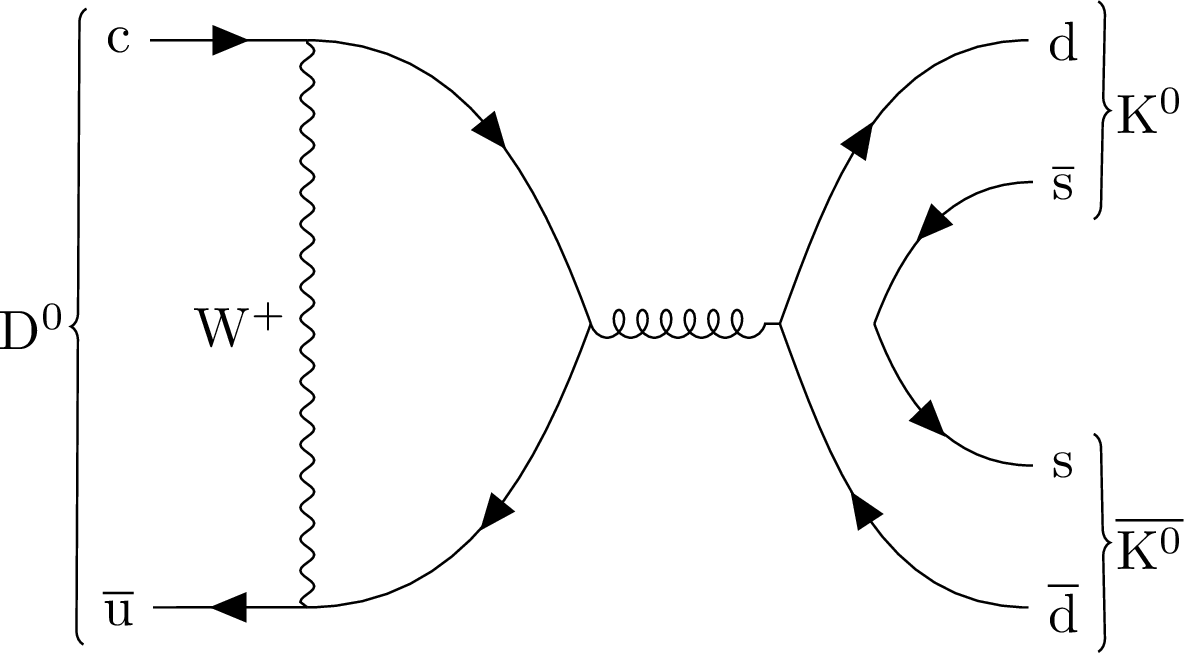
png pdf |
Figure 1-b:
The decay of neutral charm meson $ \mathrm{D^0} $ (top) or $ \overline{\mathrm{D}}^{0} $ (bottom) to two neutral kaons: exchange diagram (left) and penguin annihilation diagram (right). |
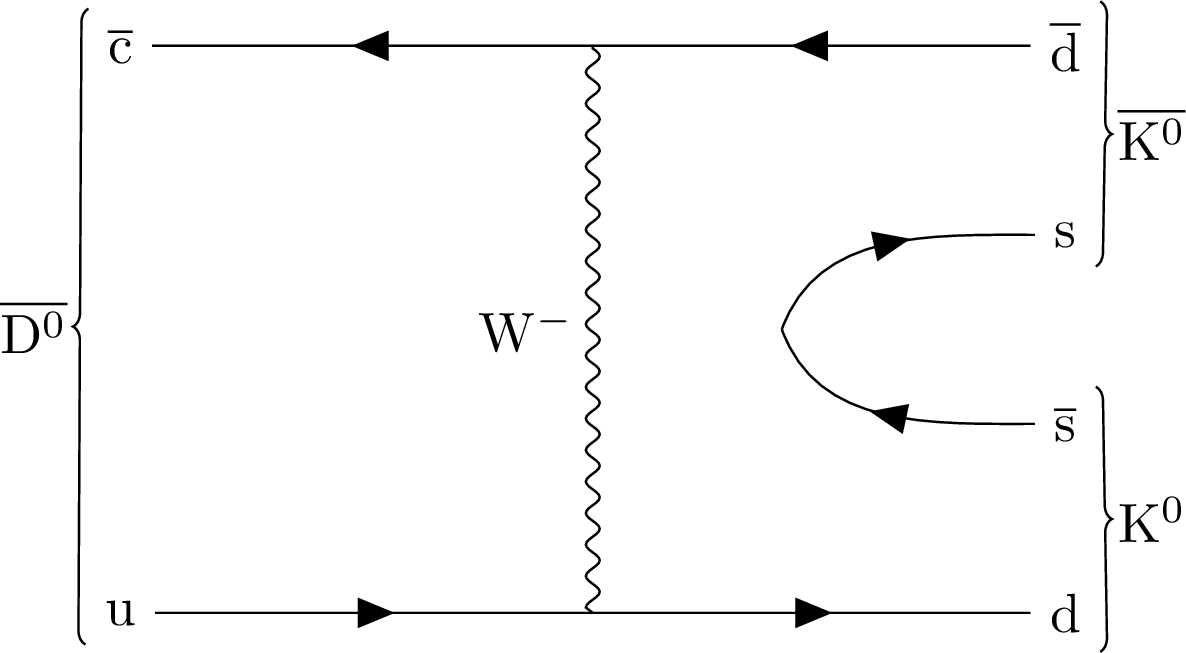
png pdf |
Figure 1-c:
The decay of neutral charm meson $ \mathrm{D^0} $ (top) or $ \overline{\mathrm{D}}^{0} $ (bottom) to two neutral kaons: exchange diagram (left) and penguin annihilation diagram (right). |

png pdf |
Figure 1-d:
The decay of neutral charm meson $ \mathrm{D^0} $ (top) or $ \overline{\mathrm{D}}^{0} $ (bottom) to two neutral kaons: exchange diagram (left) and penguin annihilation diagram (right). |

png pdf |
Figure 2:
Simultaneous fit of the $ \mathrm{D}^{*+} $ (left) and $ \mathrm{D}^{*-} $ (right) candidate invariant mass distributions in the $ \mathrm{K^0_S}\pi^{+}\pi^{-} $ channel. |

png pdf |
Figure 2-a:
Simultaneous fit of the $ \mathrm{D}^{*+} $ (left) and $ \mathrm{D}^{*-} $ (right) candidate invariant mass distributions in the $ \mathrm{K^0_S}\pi^{+}\pi^{-} $ channel. |

png pdf |
Figure 2-b:
Simultaneous fit of the $ \mathrm{D}^{*+} $ (left) and $ \mathrm{D}^{*-} $ (right) candidate invariant mass distributions in the $ \mathrm{K^0_S}\pi^{+}\pi^{-} $ channel. |

png pdf |
Figure 3:
Results of the 2D fit to $ m(\mathrm{D}\pi^{\pm}) \times\ m(\mathrm{K^0_S}\mathrm{K^0_S}) $ distribution for the signal channel, for $ \mathrm{D}^{*+} $ (left) and $ \mathrm{D}^{*-} $ (right) candidates: projections of the 2D fit on the $ m(\mathrm{D}\pi^{\pm}) $ (top) and $ m(\mathrm{K^0_S}\mathrm{K^0_S}) $ (bottom) axes. |

png pdf |
Figure 3-a:
Results of the 2D fit to $ m(\mathrm{D}\pi^{\pm}) \times\ m(\mathrm{K^0_S}\mathrm{K^0_S}) $ distribution for the signal channel, for $ \mathrm{D}^{*+} $ (left) and $ \mathrm{D}^{*-} $ (right) candidates: projections of the 2D fit on the $ m(\mathrm{D}\pi^{\pm}) $ (top) and $ m(\mathrm{K^0_S}\mathrm{K^0_S}) $ (bottom) axes. |

png pdf |
Figure 3-b:
Results of the 2D fit to $ m(\mathrm{D}\pi^{\pm}) \times\ m(\mathrm{K^0_S}\mathrm{K^0_S}) $ distribution for the signal channel, for $ \mathrm{D}^{*+} $ (left) and $ \mathrm{D}^{*-} $ (right) candidates: projections of the 2D fit on the $ m(\mathrm{D}\pi^{\pm}) $ (top) and $ m(\mathrm{K^0_S}\mathrm{K^0_S}) $ (bottom) axes. |

png pdf |
Figure 3-c:
Results of the 2D fit to $ m(\mathrm{D}\pi^{\pm}) \times\ m(\mathrm{K^0_S}\mathrm{K^0_S}) $ distribution for the signal channel, for $ \mathrm{D}^{*+} $ (left) and $ \mathrm{D}^{*-} $ (right) candidates: projections of the 2D fit on the $ m(\mathrm{D}\pi^{\pm}) $ (top) and $ m(\mathrm{K^0_S}\mathrm{K^0_S}) $ (bottom) axes. |
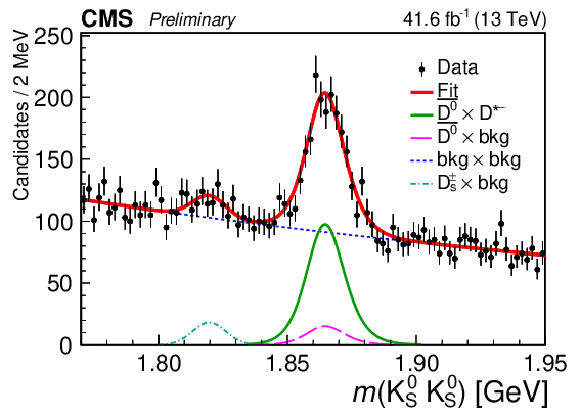
png pdf |
Figure 3-d:
Results of the 2D fit to $ m(\mathrm{D}\pi^{\pm}) \times\ m(\mathrm{K^0_S}\mathrm{K^0_S}) $ distribution for the signal channel, for $ \mathrm{D}^{*+} $ (left) and $ \mathrm{D}^{*-} $ (right) candidates: projections of the 2D fit on the $ m(\mathrm{D}\pi^{\pm}) $ (top) and $ m(\mathrm{K^0_S}\mathrm{K^0_S}) $ (bottom) axes. |

png pdf |
Figure 4:
Results of the 2D fit to $ m(\mathrm{D}\pi^{\pm}):m(\mathrm{K^0_S}\mathrm{K^0_S}) $ for the signal channel in measured data, $ \mathrm{D}^{*+} $ candidates. Top row: the projections of the 2D fit on $ m(\mathrm{D}\pi^{\pm}) $ in the ranges of $ m(\mathrm{K^0_S}\mathrm{K^0_S}) $: region of $ \mathrm{D}_{s}^{\pm}\to\mathrm{K^0_S}\mathrm{K^0_S}\pi^{\pm} $ contamination (left) and signal region of $ \mathrm{K^0_S}\mathrm{K^0_S} $ (right). Middle row: projections of the 2D fit on $ m(\mathrm{D}\pi^{\pm}) $ in the ranges of $ m(\mathrm{K^0_S}\mathrm{K^0_S}) $: left sideband (left) and right sideband (right). Bottom row: projections of the 2D fit on $ m(\mathrm{K^0_S}\mathrm{K^0_S}) $ in the ranges of $ m(\mathrm{D}\pi^{\pm}) $: left sideband (left), signal region of $ \mathrm{D^0}\pi^{+} $ (center), and right sideband (right). The green line corresponds to the signal component, the blue short-dashed line shows the combinatorial background, the purple long-dashed line shows the combinations of $ \mathrm{D^0} $ with background pions, and the magenta dash-dotted line illustrates the contamination of $ \mathrm{D}_{s}^{\pm}\to\mathrm{K^0_S}\mathrm{K^0_S}\pi^{\pm} $ decay. |

png pdf |
Figure 4-a:
Results of the 2D fit to $ m(\mathrm{D}\pi^{\pm}):m(\mathrm{K^0_S}\mathrm{K^0_S}) $ for the signal channel in measured data, $ \mathrm{D}^{*+} $ candidates. Top row: the projections of the 2D fit on $ m(\mathrm{D}\pi^{\pm}) $ in the ranges of $ m(\mathrm{K^0_S}\mathrm{K^0_S}) $: region of $ \mathrm{D}_{s}^{\pm}\to\mathrm{K^0_S}\mathrm{K^0_S}\pi^{\pm} $ contamination (left) and signal region of $ \mathrm{K^0_S}\mathrm{K^0_S} $ (right). Middle row: projections of the 2D fit on $ m(\mathrm{D}\pi^{\pm}) $ in the ranges of $ m(\mathrm{K^0_S}\mathrm{K^0_S}) $: left sideband (left) and right sideband (right). Bottom row: projections of the 2D fit on $ m(\mathrm{K^0_S}\mathrm{K^0_S}) $ in the ranges of $ m(\mathrm{D}\pi^{\pm}) $: left sideband (left), signal region of $ \mathrm{D^0}\pi^{+} $ (center), and right sideband (right). The green line corresponds to the signal component, the blue short-dashed line shows the combinatorial background, the purple long-dashed line shows the combinations of $ \mathrm{D^0} $ with background pions, and the magenta dash-dotted line illustrates the contamination of $ \mathrm{D}_{s}^{\pm}\to\mathrm{K^0_S}\mathrm{K^0_S}\pi^{\pm} $ decay. |

png pdf |
Figure 4-b:
Results of the 2D fit to $ m(\mathrm{D}\pi^{\pm}):m(\mathrm{K^0_S}\mathrm{K^0_S}) $ for the signal channel in measured data, $ \mathrm{D}^{*+} $ candidates. Top row: the projections of the 2D fit on $ m(\mathrm{D}\pi^{\pm}) $ in the ranges of $ m(\mathrm{K^0_S}\mathrm{K^0_S}) $: region of $ \mathrm{D}_{s}^{\pm}\to\mathrm{K^0_S}\mathrm{K^0_S}\pi^{\pm} $ contamination (left) and signal region of $ \mathrm{K^0_S}\mathrm{K^0_S} $ (right). Middle row: projections of the 2D fit on $ m(\mathrm{D}\pi^{\pm}) $ in the ranges of $ m(\mathrm{K^0_S}\mathrm{K^0_S}) $: left sideband (left) and right sideband (right). Bottom row: projections of the 2D fit on $ m(\mathrm{K^0_S}\mathrm{K^0_S}) $ in the ranges of $ m(\mathrm{D}\pi^{\pm}) $: left sideband (left), signal region of $ \mathrm{D^0}\pi^{+} $ (center), and right sideband (right). The green line corresponds to the signal component, the blue short-dashed line shows the combinatorial background, the purple long-dashed line shows the combinations of $ \mathrm{D^0} $ with background pions, and the magenta dash-dotted line illustrates the contamination of $ \mathrm{D}_{s}^{\pm}\to\mathrm{K^0_S}\mathrm{K^0_S}\pi^{\pm} $ decay. |

png pdf |
Figure 4-c:
Results of the 2D fit to $ m(\mathrm{D}\pi^{\pm}):m(\mathrm{K^0_S}\mathrm{K^0_S}) $ for the signal channel in measured data, $ \mathrm{D}^{*+} $ candidates. Top row: the projections of the 2D fit on $ m(\mathrm{D}\pi^{\pm}) $ in the ranges of $ m(\mathrm{K^0_S}\mathrm{K^0_S}) $: region of $ \mathrm{D}_{s}^{\pm}\to\mathrm{K^0_S}\mathrm{K^0_S}\pi^{\pm} $ contamination (left) and signal region of $ \mathrm{K^0_S}\mathrm{K^0_S} $ (right). Middle row: projections of the 2D fit on $ m(\mathrm{D}\pi^{\pm}) $ in the ranges of $ m(\mathrm{K^0_S}\mathrm{K^0_S}) $: left sideband (left) and right sideband (right). Bottom row: projections of the 2D fit on $ m(\mathrm{K^0_S}\mathrm{K^0_S}) $ in the ranges of $ m(\mathrm{D}\pi^{\pm}) $: left sideband (left), signal region of $ \mathrm{D^0}\pi^{+} $ (center), and right sideband (right). The green line corresponds to the signal component, the blue short-dashed line shows the combinatorial background, the purple long-dashed line shows the combinations of $ \mathrm{D^0} $ with background pions, and the magenta dash-dotted line illustrates the contamination of $ \mathrm{D}_{s}^{\pm}\to\mathrm{K^0_S}\mathrm{K^0_S}\pi^{\pm} $ decay. |

png pdf |
Figure 4-d:
Results of the 2D fit to $ m(\mathrm{D}\pi^{\pm}):m(\mathrm{K^0_S}\mathrm{K^0_S}) $ for the signal channel in measured data, $ \mathrm{D}^{*+} $ candidates. Top row: the projections of the 2D fit on $ m(\mathrm{D}\pi^{\pm}) $ in the ranges of $ m(\mathrm{K^0_S}\mathrm{K^0_S}) $: region of $ \mathrm{D}_{s}^{\pm}\to\mathrm{K^0_S}\mathrm{K^0_S}\pi^{\pm} $ contamination (left) and signal region of $ \mathrm{K^0_S}\mathrm{K^0_S} $ (right). Middle row: projections of the 2D fit on $ m(\mathrm{D}\pi^{\pm}) $ in the ranges of $ m(\mathrm{K^0_S}\mathrm{K^0_S}) $: left sideband (left) and right sideband (right). Bottom row: projections of the 2D fit on $ m(\mathrm{K^0_S}\mathrm{K^0_S}) $ in the ranges of $ m(\mathrm{D}\pi^{\pm}) $: left sideband (left), signal region of $ \mathrm{D^0}\pi^{+} $ (center), and right sideband (right). The green line corresponds to the signal component, the blue short-dashed line shows the combinatorial background, the purple long-dashed line shows the combinations of $ \mathrm{D^0} $ with background pions, and the magenta dash-dotted line illustrates the contamination of $ \mathrm{D}_{s}^{\pm}\to\mathrm{K^0_S}\mathrm{K^0_S}\pi^{\pm} $ decay. |

png pdf |
Figure 4-e:
Results of the 2D fit to $ m(\mathrm{D}\pi^{\pm}):m(\mathrm{K^0_S}\mathrm{K^0_S}) $ for the signal channel in measured data, $ \mathrm{D}^{*+} $ candidates. Top row: the projections of the 2D fit on $ m(\mathrm{D}\pi^{\pm}) $ in the ranges of $ m(\mathrm{K^0_S}\mathrm{K^0_S}) $: region of $ \mathrm{D}_{s}^{\pm}\to\mathrm{K^0_S}\mathrm{K^0_S}\pi^{\pm} $ contamination (left) and signal region of $ \mathrm{K^0_S}\mathrm{K^0_S} $ (right). Middle row: projections of the 2D fit on $ m(\mathrm{D}\pi^{\pm}) $ in the ranges of $ m(\mathrm{K^0_S}\mathrm{K^0_S}) $: left sideband (left) and right sideband (right). Bottom row: projections of the 2D fit on $ m(\mathrm{K^0_S}\mathrm{K^0_S}) $ in the ranges of $ m(\mathrm{D}\pi^{\pm}) $: left sideband (left), signal region of $ \mathrm{D^0}\pi^{+} $ (center), and right sideband (right). The green line corresponds to the signal component, the blue short-dashed line shows the combinatorial background, the purple long-dashed line shows the combinations of $ \mathrm{D^0} $ with background pions, and the magenta dash-dotted line illustrates the contamination of $ \mathrm{D}_{s}^{\pm}\to\mathrm{K^0_S}\mathrm{K^0_S}\pi^{\pm} $ decay. |

png pdf |
Figure 4-f:
Results of the 2D fit to $ m(\mathrm{D}\pi^{\pm}):m(\mathrm{K^0_S}\mathrm{K^0_S}) $ for the signal channel in measured data, $ \mathrm{D}^{*+} $ candidates. Top row: the projections of the 2D fit on $ m(\mathrm{D}\pi^{\pm}) $ in the ranges of $ m(\mathrm{K^0_S}\mathrm{K^0_S}) $: region of $ \mathrm{D}_{s}^{\pm}\to\mathrm{K^0_S}\mathrm{K^0_S}\pi^{\pm} $ contamination (left) and signal region of $ \mathrm{K^0_S}\mathrm{K^0_S} $ (right). Middle row: projections of the 2D fit on $ m(\mathrm{D}\pi^{\pm}) $ in the ranges of $ m(\mathrm{K^0_S}\mathrm{K^0_S}) $: left sideband (left) and right sideband (right). Bottom row: projections of the 2D fit on $ m(\mathrm{K^0_S}\mathrm{K^0_S}) $ in the ranges of $ m(\mathrm{D}\pi^{\pm}) $: left sideband (left), signal region of $ \mathrm{D^0}\pi^{+} $ (center), and right sideband (right). The green line corresponds to the signal component, the blue short-dashed line shows the combinatorial background, the purple long-dashed line shows the combinations of $ \mathrm{D^0} $ with background pions, and the magenta dash-dotted line illustrates the contamination of $ \mathrm{D}_{s}^{\pm}\to\mathrm{K^0_S}\mathrm{K^0_S}\pi^{\pm} $ decay. |

png pdf |
Figure 4-g:
Results of the 2D fit to $ m(\mathrm{D}\pi^{\pm}):m(\mathrm{K^0_S}\mathrm{K^0_S}) $ for the signal channel in measured data, $ \mathrm{D}^{*+} $ candidates. Top row: the projections of the 2D fit on $ m(\mathrm{D}\pi^{\pm}) $ in the ranges of $ m(\mathrm{K^0_S}\mathrm{K^0_S}) $: region of $ \mathrm{D}_{s}^{\pm}\to\mathrm{K^0_S}\mathrm{K^0_S}\pi^{\pm} $ contamination (left) and signal region of $ \mathrm{K^0_S}\mathrm{K^0_S} $ (right). Middle row: projections of the 2D fit on $ m(\mathrm{D}\pi^{\pm}) $ in the ranges of $ m(\mathrm{K^0_S}\mathrm{K^0_S}) $: left sideband (left) and right sideband (right). Bottom row: projections of the 2D fit on $ m(\mathrm{K^0_S}\mathrm{K^0_S}) $ in the ranges of $ m(\mathrm{D}\pi^{\pm}) $: left sideband (left), signal region of $ \mathrm{D^0}\pi^{+} $ (center), and right sideband (right). The green line corresponds to the signal component, the blue short-dashed line shows the combinatorial background, the purple long-dashed line shows the combinations of $ \mathrm{D^0} $ with background pions, and the magenta dash-dotted line illustrates the contamination of $ \mathrm{D}_{s}^{\pm}\to\mathrm{K^0_S}\mathrm{K^0_S}\pi^{\pm} $ decay. |
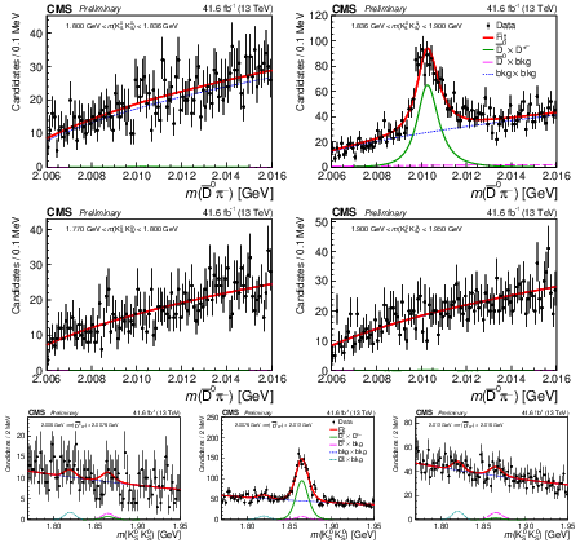
png pdf |
Figure 5:
Results of the 2D fit to $ m(\mathrm{D}\pi^{\pm}):m(\mathrm{K^0_S}\mathrm{K^0_S}) $ for the signal channel in measured data, $ \mathrm{D}^{*-} $ candidates. Top row: the projections of the 2D fit on $ m(\mathrm{D}\pi^{\pm}) $ in the ranges of $ m(\mathrm{K^0_S}\mathrm{K^0_S}) $: region of $ \mathrm{D}_{s}^{\pm}\to\mathrm{K^0_S}\mathrm{K^0_S}\pi^{\pm} $ contamination (left) and signal region of $ \mathrm{K^0_S}\mathrm{K^0_S} $ (right). Middle row: projections of the 2D fit on $ m(\mathrm{D}\pi^{\pm}) $ in the ranges of $ m(\mathrm{K^0_S}\mathrm{K^0_S}) $: left sideband (left) and right sideband (right). Bottom row: projections of the 2D fit on $ m(\mathrm{K^0_S}\mathrm{K^0_S}) $ in the ranges of $ m(\mathrm{D}\pi^{\pm}) $: left sideband (left), signal region of $ \overline{\mathrm{D}}^{0}\pi^{-} $ (center), and right sideband (right). The green line corresponds to the signal component, the blue short-dashed line shows the combinatorial background, the purple long-dashed line shows the combinations of $ \overline{\mathrm{D}}^{0} $ with background pions, and the magenta dash-dotted line illustrates the contamination of $ \mathrm{D}_{s}^{\pm}\to\mathrm{K^0_S}\mathrm{K^0_S}\pi^{\pm} $ decay. |
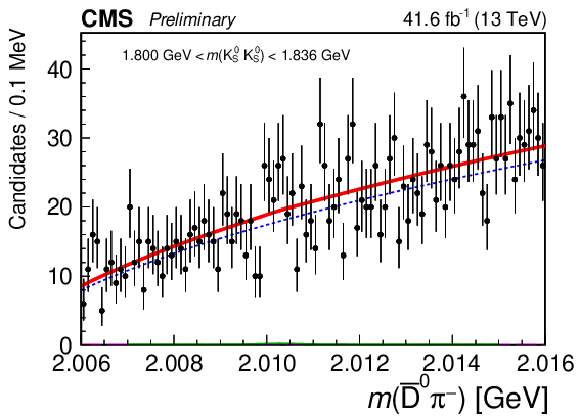
png pdf |
Figure 5-a:
Results of the 2D fit to $ m(\mathrm{D}\pi^{\pm}):m(\mathrm{K^0_S}\mathrm{K^0_S}) $ for the signal channel in measured data, $ \mathrm{D}^{*-} $ candidates. Top row: the projections of the 2D fit on $ m(\mathrm{D}\pi^{\pm}) $ in the ranges of $ m(\mathrm{K^0_S}\mathrm{K^0_S}) $: region of $ \mathrm{D}_{s}^{\pm}\to\mathrm{K^0_S}\mathrm{K^0_S}\pi^{\pm} $ contamination (left) and signal region of $ \mathrm{K^0_S}\mathrm{K^0_S} $ (right). Middle row: projections of the 2D fit on $ m(\mathrm{D}\pi^{\pm}) $ in the ranges of $ m(\mathrm{K^0_S}\mathrm{K^0_S}) $: left sideband (left) and right sideband (right). Bottom row: projections of the 2D fit on $ m(\mathrm{K^0_S}\mathrm{K^0_S}) $ in the ranges of $ m(\mathrm{D}\pi^{\pm}) $: left sideband (left), signal region of $ \overline{\mathrm{D}}^{0}\pi^{-} $ (center), and right sideband (right). The green line corresponds to the signal component, the blue short-dashed line shows the combinatorial background, the purple long-dashed line shows the combinations of $ \overline{\mathrm{D}}^{0} $ with background pions, and the magenta dash-dotted line illustrates the contamination of $ \mathrm{D}_{s}^{\pm}\to\mathrm{K^0_S}\mathrm{K^0_S}\pi^{\pm} $ decay. |

png pdf |
Figure 5-b:
Results of the 2D fit to $ m(\mathrm{D}\pi^{\pm}):m(\mathrm{K^0_S}\mathrm{K^0_S}) $ for the signal channel in measured data, $ \mathrm{D}^{*-} $ candidates. Top row: the projections of the 2D fit on $ m(\mathrm{D}\pi^{\pm}) $ in the ranges of $ m(\mathrm{K^0_S}\mathrm{K^0_S}) $: region of $ \mathrm{D}_{s}^{\pm}\to\mathrm{K^0_S}\mathrm{K^0_S}\pi^{\pm} $ contamination (left) and signal region of $ \mathrm{K^0_S}\mathrm{K^0_S} $ (right). Middle row: projections of the 2D fit on $ m(\mathrm{D}\pi^{\pm}) $ in the ranges of $ m(\mathrm{K^0_S}\mathrm{K^0_S}) $: left sideband (left) and right sideband (right). Bottom row: projections of the 2D fit on $ m(\mathrm{K^0_S}\mathrm{K^0_S}) $ in the ranges of $ m(\mathrm{D}\pi^{\pm}) $: left sideband (left), signal region of $ \overline{\mathrm{D}}^{0}\pi^{-} $ (center), and right sideband (right). The green line corresponds to the signal component, the blue short-dashed line shows the combinatorial background, the purple long-dashed line shows the combinations of $ \overline{\mathrm{D}}^{0} $ with background pions, and the magenta dash-dotted line illustrates the contamination of $ \mathrm{D}_{s}^{\pm}\to\mathrm{K^0_S}\mathrm{K^0_S}\pi^{\pm} $ decay. |
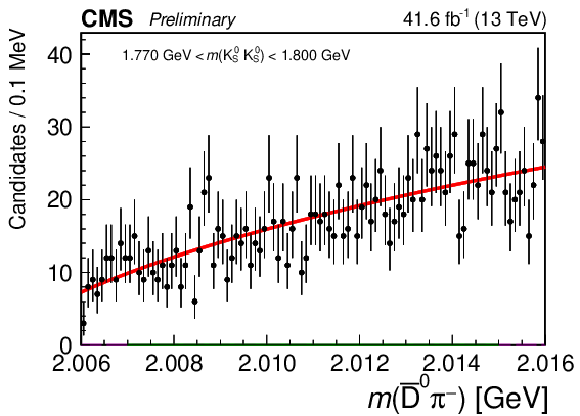
png pdf |
Figure 5-c:
Results of the 2D fit to $ m(\mathrm{D}\pi^{\pm}):m(\mathrm{K^0_S}\mathrm{K^0_S}) $ for the signal channel in measured data, $ \mathrm{D}^{*-} $ candidates. Top row: the projections of the 2D fit on $ m(\mathrm{D}\pi^{\pm}) $ in the ranges of $ m(\mathrm{K^0_S}\mathrm{K^0_S}) $: region of $ \mathrm{D}_{s}^{\pm}\to\mathrm{K^0_S}\mathrm{K^0_S}\pi^{\pm} $ contamination (left) and signal region of $ \mathrm{K^0_S}\mathrm{K^0_S} $ (right). Middle row: projections of the 2D fit on $ m(\mathrm{D}\pi^{\pm}) $ in the ranges of $ m(\mathrm{K^0_S}\mathrm{K^0_S}) $: left sideband (left) and right sideband (right). Bottom row: projections of the 2D fit on $ m(\mathrm{K^0_S}\mathrm{K^0_S}) $ in the ranges of $ m(\mathrm{D}\pi^{\pm}) $: left sideband (left), signal region of $ \overline{\mathrm{D}}^{0}\pi^{-} $ (center), and right sideband (right). The green line corresponds to the signal component, the blue short-dashed line shows the combinatorial background, the purple long-dashed line shows the combinations of $ \overline{\mathrm{D}}^{0} $ with background pions, and the magenta dash-dotted line illustrates the contamination of $ \mathrm{D}_{s}^{\pm}\to\mathrm{K^0_S}\mathrm{K^0_S}\pi^{\pm} $ decay. |

png pdf |
Figure 5-d:
Results of the 2D fit to $ m(\mathrm{D}\pi^{\pm}):m(\mathrm{K^0_S}\mathrm{K^0_S}) $ for the signal channel in measured data, $ \mathrm{D}^{*-} $ candidates. Top row: the projections of the 2D fit on $ m(\mathrm{D}\pi^{\pm}) $ in the ranges of $ m(\mathrm{K^0_S}\mathrm{K^0_S}) $: region of $ \mathrm{D}_{s}^{\pm}\to\mathrm{K^0_S}\mathrm{K^0_S}\pi^{\pm} $ contamination (left) and signal region of $ \mathrm{K^0_S}\mathrm{K^0_S} $ (right). Middle row: projections of the 2D fit on $ m(\mathrm{D}\pi^{\pm}) $ in the ranges of $ m(\mathrm{K^0_S}\mathrm{K^0_S}) $: left sideband (left) and right sideband (right). Bottom row: projections of the 2D fit on $ m(\mathrm{K^0_S}\mathrm{K^0_S}) $ in the ranges of $ m(\mathrm{D}\pi^{\pm}) $: left sideband (left), signal region of $ \overline{\mathrm{D}}^{0}\pi^{-} $ (center), and right sideband (right). The green line corresponds to the signal component, the blue short-dashed line shows the combinatorial background, the purple long-dashed line shows the combinations of $ \overline{\mathrm{D}}^{0} $ with background pions, and the magenta dash-dotted line illustrates the contamination of $ \mathrm{D}_{s}^{\pm}\to\mathrm{K^0_S}\mathrm{K^0_S}\pi^{\pm} $ decay. |

png pdf |
Figure 5-e:
Results of the 2D fit to $ m(\mathrm{D}\pi^{\pm}):m(\mathrm{K^0_S}\mathrm{K^0_S}) $ for the signal channel in measured data, $ \mathrm{D}^{*-} $ candidates. Top row: the projections of the 2D fit on $ m(\mathrm{D}\pi^{\pm}) $ in the ranges of $ m(\mathrm{K^0_S}\mathrm{K^0_S}) $: region of $ \mathrm{D}_{s}^{\pm}\to\mathrm{K^0_S}\mathrm{K^0_S}\pi^{\pm} $ contamination (left) and signal region of $ \mathrm{K^0_S}\mathrm{K^0_S} $ (right). Middle row: projections of the 2D fit on $ m(\mathrm{D}\pi^{\pm}) $ in the ranges of $ m(\mathrm{K^0_S}\mathrm{K^0_S}) $: left sideband (left) and right sideband (right). Bottom row: projections of the 2D fit on $ m(\mathrm{K^0_S}\mathrm{K^0_S}) $ in the ranges of $ m(\mathrm{D}\pi^{\pm}) $: left sideband (left), signal region of $ \overline{\mathrm{D}}^{0}\pi^{-} $ (center), and right sideband (right). The green line corresponds to the signal component, the blue short-dashed line shows the combinatorial background, the purple long-dashed line shows the combinations of $ \overline{\mathrm{D}}^{0} $ with background pions, and the magenta dash-dotted line illustrates the contamination of $ \mathrm{D}_{s}^{\pm}\to\mathrm{K^0_S}\mathrm{K^0_S}\pi^{\pm} $ decay. |

png pdf |
Figure 5-f:
Results of the 2D fit to $ m(\mathrm{D}\pi^{\pm}):m(\mathrm{K^0_S}\mathrm{K^0_S}) $ for the signal channel in measured data, $ \mathrm{D}^{*-} $ candidates. Top row: the projections of the 2D fit on $ m(\mathrm{D}\pi^{\pm}) $ in the ranges of $ m(\mathrm{K^0_S}\mathrm{K^0_S}) $: region of $ \mathrm{D}_{s}^{\pm}\to\mathrm{K^0_S}\mathrm{K^0_S}\pi^{\pm} $ contamination (left) and signal region of $ \mathrm{K^0_S}\mathrm{K^0_S} $ (right). Middle row: projections of the 2D fit on $ m(\mathrm{D}\pi^{\pm}) $ in the ranges of $ m(\mathrm{K^0_S}\mathrm{K^0_S}) $: left sideband (left) and right sideband (right). Bottom row: projections of the 2D fit on $ m(\mathrm{K^0_S}\mathrm{K^0_S}) $ in the ranges of $ m(\mathrm{D}\pi^{\pm}) $: left sideband (left), signal region of $ \overline{\mathrm{D}}^{0}\pi^{-} $ (center), and right sideband (right). The green line corresponds to the signal component, the blue short-dashed line shows the combinatorial background, the purple long-dashed line shows the combinations of $ \overline{\mathrm{D}}^{0} $ with background pions, and the magenta dash-dotted line illustrates the contamination of $ \mathrm{D}_{s}^{\pm}\to\mathrm{K^0_S}\mathrm{K^0_S}\pi^{\pm} $ decay. |

png pdf |
Figure 5-g:
Results of the 2D fit to $ m(\mathrm{D}\pi^{\pm}):m(\mathrm{K^0_S}\mathrm{K^0_S}) $ for the signal channel in measured data, $ \mathrm{D}^{*-} $ candidates. Top row: the projections of the 2D fit on $ m(\mathrm{D}\pi^{\pm}) $ in the ranges of $ m(\mathrm{K^0_S}\mathrm{K^0_S}) $: region of $ \mathrm{D}_{s}^{\pm}\to\mathrm{K^0_S}\mathrm{K^0_S}\pi^{\pm} $ contamination (left) and signal region of $ \mathrm{K^0_S}\mathrm{K^0_S} $ (right). Middle row: projections of the 2D fit on $ m(\mathrm{D}\pi^{\pm}) $ in the ranges of $ m(\mathrm{K^0_S}\mathrm{K^0_S}) $: left sideband (left) and right sideband (right). Bottom row: projections of the 2D fit on $ m(\mathrm{K^0_S}\mathrm{K^0_S}) $ in the ranges of $ m(\mathrm{D}\pi^{\pm}) $: left sideband (left), signal region of $ \overline{\mathrm{D}}^{0}\pi^{-} $ (center), and right sideband (right). The green line corresponds to the signal component, the blue short-dashed line shows the combinatorial background, the purple long-dashed line shows the combinations of $ \overline{\mathrm{D}}^{0} $ with background pions, and the magenta dash-dotted line illustrates the contamination of $ \mathrm{D}_{s}^{\pm}\to\mathrm{K^0_S}\mathrm{K^0_S}\pi^{\pm} $ decay. |
| Tables | |

png pdf |
Table 1:
Optimized selection criteria in the signal channel $ \mathrm{D^0}\to\mathrm{K^0_S}\mathrm{K^0_S} $. |

png pdf |
Table 2:
Results of the simultaneous fit to the selected $ \mathrm{D}^{*+}\to\mathrm{D^0}\pi^{+} $ and $ \mathrm{D}^{*-}\to\overline{\mathrm{D}}^{0}\pi^{-} $ candidates, where $ \mathrm{D^0}\,(\overline{\mathrm{D}}^{0}) \to\mathrm{K^0_S}\pi^{+}\pi^{-} $. The $ {\mathrm{D}^{\ast}(2010)^{\pm}} $ signal yields $ N $ given in the second column are used in the evaluation of $ A_{CP}^{\text{raw}} $. The uncertainties are statistical only. |

png pdf |
Table 3:
Results of the simultaneous 2D fit to the selected $ \mathrm{D}^{*+}\to\mathrm{D^0}\pi^{+} $ and $ \mathrm{D}^{*-}\to\overline{\mathrm{D}}^{0}\pi^{-} $ candidates, where $ \mathrm{D^0}\,(\overline{\mathrm{D}}^{0}) \to\mathrm{K^0_S}\mathrm{K^0_S} $. The yields $ N $ given in the second column correspond to the $ \mathrm{D^0} \,\times\,{\mathrm{D}^{\ast}(2010)^{\pm}} $ component in the 2D fit and are used in the evaluation of $ A_{CP}^{\text{raw}} $. The $ \chi^2 $ corresponds to the fit projection with 100 bins in the $ x=m(\mathrm{D}\pi^{\pm}) $ axis and 90 bins in the $ y=m(\mathrm{K^0_S}\mathrm{K^0_S}) $ axis, as shown in Fig 3. The uncertainties are statistical only. |

png pdf |
Table 4:
Absolute systematic uncertainties in the measurement of $ \Delta A_{CP} $. |
| Summary |
| This is the first CMS measurement of $ CP $ violation in the charm sector, paving the way for future measurements with more data, using refined techniques, and in different channels. |
| References | ||||
| 1 | A. D. Sakharov | Violation of CP invariance, C asymmetry, and baryon asymmetry of the universe | Sov. Phys. Usp. 34 (1991) 392 | |
| 2 | N. Cabibbo | Unitary symmetry and leptonic decays | PRL 10 (1963) 531 | |
| 3 | M. Kobayashi and T. Maskawa | CP-violation in the renormalizable theory of weak interaction | Progress of Theoretical Physics 49 (1973) 652 | |
| 4 | J. H. Christenson, J. W. Cronin, V. L. Fitch, and R. Turlay | Evidence for the 2 $ \pi $ decay of the $ K_{2}^{0} $ meson | PRL 13 (1964) 138 | |
| 5 | KTeV Collaboration | Observation of direct CP violation in $ K_{S, L} \to \pi \pi $ decays | PRL 83 (1999) 22 | hep-ex/9905060 |
| 6 | The NA48 Collaboration | A precise measurement of the direct CP violation parameter $ \operatorname{Re}\left(\varepsilon^{\prime} / \varepsilon\right) $ | Eur. Phys. J. C. 22 (2001) 231 | hep-ex/0110019 |
| 7 | BABAR Collaboration | Observation of $ \mathit{CP} $ violation in the $ {\mathit{B}}^{0} $ meson system | PRL 87 (2001) 091801 | hep-ex/0107013 |
| 8 | The Belle Collaboration | Observation of large CP-violation in the neutral B meson system | PRL 87 (2001) | hep-ex/0107061 |
| 9 | BABAR Collaboration | Direct $ CP $ violating asymmetry in $ {B}^{0}\rightarrow{K}^{+}{\pi}^{-} $ decays | PRL 93 (2004) 131801 | hep-ex/0407057 |
| 10 | Belle Collaboration | Evidence for direct $ CP $ violation in $ {B}^{0}\rightarrow{K}^{+}{\pi}^{-} $ decays | PRL 93 (2004) 191802 | hep-ex/0408100 |
| 11 | LHCb Collaboration | First observation of $ CP $ violation in the decays of $ {B}_{s}^{0} $ mesons | PRL 110 (2013) 221601 | 1304.6173 |
| 12 | LHCb Collaboration | Observation of CP violation in $ B^{ \pm} \rightarrow D K^{ \pm} $ decays | PLB 712 (2012) 203 | 1203.3662 |
| 13 | A. G. Cohen, D. B. Kaplan, and A. E. Nelson | Progress in electroweak baryogenesis | Annual Review of Nuclear and Particle Science 43 (1993) 27 | hep-ph/9302210 |
| 14 | A. Riotto and M. Trodden | Recent progress in baryogenesis | Annual Review of Nuclear and Particle Science 49 (1999) 35 | hep-ph/9901362 |
| 15 | W.-S. Hou | Source of CP violation for the baryon asymmetry of the Universe | Chin. J. Phys. 47 (2009) 134 | 0803.1234 |
| 16 | S. L. Glashow, J. Iliopoulos, and L. Maiani | Weak interactions with lepton-hadron symmetry | PRD 2 (1970) 1285 | |
| 17 | LHCb Collaboration | Observation of CP violation in charm decays | PRL 122 (2019) 211803 | 1903.08726 |
| 18 | A. Lenz and G. Wilkinson | Mixing and CP violation in the charm system | Ann. Rev. Nucl. Part. Sci. 71 (2021) 59 | 2011.04443 |
| 19 | Particle Data Group Collaboration | Review of particle physics | PTEP 2022 (2022) 083C01 | |
| 20 | U. Nierste and S. Schacht | $ CP $ violation in $ {D}^{0}\rightarrow{K}_{S}{K}_{S} $ | PRD 92 (2015) 054036 | 1508.00074 |
| 21 | H.-n. Li, C.-D. Lu, and F.-S. Yu | Branching ratios and direct $ CP $ asymmetries in $ D \rightarrow \pi\pi $ decays | PRD 86 (2012) 036012 | 1203.3120 |
| 22 | H.-Y. Cheng and C.-W. Chiang | Revisiting $ CP $ violation in $ D\rightarrow\pi\pi $ and $ VP $ decays | PRD 100 (2019) 093002 | 1909.03063 |
| 23 | F. Buccella, A. Paul, and P. Santorelli | $ SU(3{)}_{F} $ breaking through final state interactions and $ CP $ asymmetries in $ D\rightarrow\pi\pi $ decays | PRD 99 (2019) 113001 | 1902.05564 |
| 24 | J. Brod, A. L. Kagan, and J. Zupan | Size of direct $ CP $ violation in singly Cabibbo-suppressed $ D $ decays | PRD 86 (2012) 014023 | 1111.5000 |
| 25 | LHCb Collaboration | Measurement of $ CP $ asymmetry in $ D^0 \to K^0_S K^0_S $ decays | PRD 104 (2021) L031102 | 2105.01565 |
| 26 | N. Dash et al. | Search for $ CP $ violation and measurement of the branching fraction in the decay $ D^{0} \to K^0_S K^0_S $ | PRL 119 (2017) 171801 | 1705.05966 |
| 27 | CDF Collaboration | Measurement of CP-violation asymmetries in $ D^{0} \to K^{0}_{S} \pi^+ \pi^- $ | PRD 86 (2012) 032007 | 1207.0825 |
| 28 | CMS Collaboration | HEPData record for this analysis | link | |
| 29 | CMS Collaboration | Recording and reconstructing 10 billion unbiased b hadron decays in CMS | CMS Detector Performance Summary CMS-DP-2019-043, 2019 CDS |
|
| 30 | CMS Collaboration | Test of lepton flavor universality in B$ ^{\pm} \to $ K$ ^{\pm}\mu^+\mu^- $ and B$ ^{\pm} \to $ K$ ^{\pm} $e$ ^+ $e$ ^- $ decays in proton-proton collisions at $ \sqrt{s} = $ 13 TeV | CMS-BPH-22-005 2401.07090 |
|
| 31 | CMS Tracker Group Collaboration | The CMS Phase-1 pixel detector upgrade | JINST 16 (2021) P02027 | 2012.14304 |
| 32 | CMS Collaboration | Track impact parameter resolution for the full pseudo rapidity coverage in the 2017 dataset with the CMS Phase-1 pixel detector | CMS Detector Performance Summary CMS-DP-2020-049, 2020 CDS |
|
| 33 | CMS Collaboration | Performance of the CMS Level-1 trigger in proton-proton collisions at $ \sqrt{s} = $ 13\,TeV | JINST 15 (2020) P10017 | CMS-TRG-17-001 2006.10165 |
| 34 | CMS Collaboration | The CMS trigger system | JINST 12 (2017) P01020 | CMS-TRG-12-001 1609.02366 |
| 35 | CMS Collaboration | The CMS experiment at the CERN LHC | JINST 3 (2008) S08004 | |
| 36 | T. Sjöstrand et al. | An introduction to PYTHIA 8.2 | Comput. Phys. Commun. 191 (2015) 159 | 1410.3012 |
| 37 | D. J. Lange | The EvtGen particle decay simulation package | NIM A 462 (2001) 152 | |
| 38 | CMS Collaboration | Extraction and validation of a new set of CMS PYTHIA8 tunes from underlying-event measurements | EPJC 80 (2020) 4 | CMS-GEN-17-001 1903.12179 |
| 39 | E. Barberio and Z. Was | PHOTOS --- a universal Monte Carlo for QED radiative corrections: version 2.0 | Comput. Phys. Commun. 79 (1994) 291 | |
| 40 | GEANT4 Collaboration | GEANT 4 --- a simulation toolkit | NIM A 506 (2003) 250 | |
| 41 | CMS Collaboration | CMS tracking performance results from early LHC operation | EPJC 70 (2010) 1165 | CMS-TRK-10-001 1007.1988 |
| 42 | CMS Collaboration | Description and performance of track and primary-vertex reconstruction with the CMS tracker | JINST 9 (2014) P10009 | CMS-TRK-11-001 1405.6569 |
| 43 | N. L. Johnson | Systems of frequency curves generated by methods of translation | Biometrika 36 (1949) 149 | |
| 44 | M. J. Oreglia | A study of the reactions $ \psi^\prime \to \gamma \gamma \psi $ | PhD thesis, Stanford University, SLAC Report SLAC-R-236, 1980 link |
|
| 45 | CLEO Collaboration | Search for CP violation in $D^0 \to K^0_S \pi^{+}\pi^{-}$ | PRD 70 (2004) 091101 | hep-ex/0311033 |

|
Compact Muon Solenoid LHC, CERN |

|

|

|

|

|

|